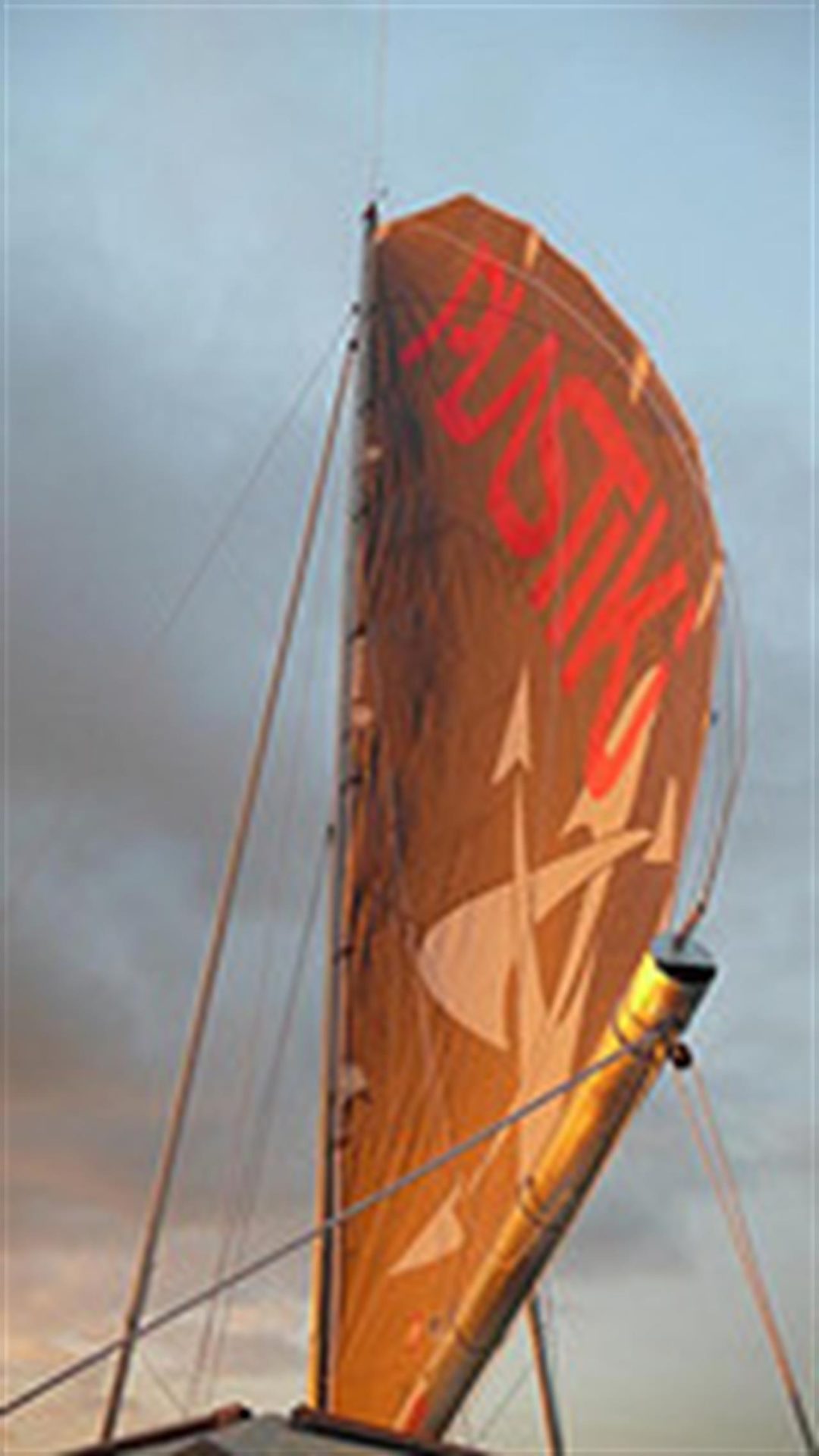Sostenibilità
Sailing across the world’s largest dump
The Plastiki team takes on the Great Pacific Garbage Patch
di Staff

The world’s biggest rubbish dump keeps growing. The Great Pacific Garbage Patch – or the Pacific Trash Vortex – is a floating monument to our culture of waste, the final resting place of every forgotten carrier bag, every discarded bottle and every piece of packaging blown away in the wind. Opinions about the exact size of this great, soupy mix vary, but some claim it has doubled over the past decade, making it now six times the size of the UK.
Dr Simon Boxall, a physical oceanographer at the National Oceanography Centre at the University of Southampton, goes even further: “It’s the size of North America. But although the patch itself is extremely large, it’s only one very clear representation of the much bigger worldwide problem.”
This global problem is the motive behind the Plastiki, a 60ft, 12-ton catamaran built from 12,500 recycled plastic bottles, which embarks on its maiden voyage from San Francisco this week. The brainchild of David de Rothschild, the flamboyant British banking heir and environmentalist, the Plastiki will sail right through the middle of the Garbage Patch as part of a campaign to help make more people aware of the Pacific’s threatened communities and of the damage our waste is doing to our oceans.
Plastic is the main issue. Fifty years ago, most flotsam was biodegradable. Now it is 90 per cent plastic. In 2006, the United Nations Environment Programme estimated that there were 46,000 pieces of floating plastic in every square mile of ocean. With its stubborn refusal to biodegrade, all plastic not buried in landfills – roughly half of it – sweeps into streams and sewers and then out into rivers and, finally, the ocean. Some of it – some say as much as 70 per cent – sinks to the ocean floor. The remainder floats, usually within 20 metres of the surface, and is carried into stable circular currents, or gyres “like ocean ring-roads”, says Dr Boxall. Once inside these gyres, the plastic is drawn by wind and surface currents towards the centre, where it steadily accumulates. The world’s major oceans all have these gyres, and all are gathering rubbish. Although the North Pacific – bordering California, Japan and China – is the biggest, there are also increasingly prominent gyres in the South Pacific, the North and South Atlantic and the Indian Oceans. Our problems with plastics are only just beginning.
The Pacific Garbage Patch had been predicted as early as the late Eighties but it was only formally discovered in 1997 by Charles Moore, an American yacht-racing captain sailing home across the North Pacific from a competition in Hawaii. He noticed a large amount of debris in the centre of the gyre, and together with the oceanographer, Curtis Ebbesmeyer, formulated the idea of the Eastern Garbage Patch. Other research revealed a secondary patch to the West, and these two together constitute the Great Pacific Patch, located roughly between 135-155°W and 35-45°N. In 1999, Moore followed up his initial findings with a report showing that there was eight times as much plastic as plankton in the North Pacific. And there is a lot of plankton.
The image of a great floating mound of trash, though evocative, can be misleading. Dr Boxall says: “People imagine it as a kind of football pitch of rubbish you can go and walk on – it’s not like that.” As most of the plastic has been broken down into tiny particles, floating beneath the surface, it is impossible to photograph from aircraft or satellites, or even really to see until you are right in its centre. As a result, it is difficult to convey the grave danger this 100 million tons or so of rubbish – and counting – presents. This is where the Plastiki – named after Thor Heyerdahl’s Kon-Tiki project in 1947 – comes in. Its crew of six is being skippered by the rising star of British ocean sailing, Jo Royle, 29. Ms Royle is everything you could want at the figurehead of your mission: blonde, vivacious and – behind a Lancastrian burr that survived her upbringing in Devon – a passionate environmentalist. She seems unfazed about sailing slap bang into the middle of the watery skip of the world.
“I can’t wait to get there,” she says. “Being in the middle of the ocean puts you back in your place – if you’re not responsive, you don’t survive. It makes you think hard about how you consume.”
However, she readily concedes that it is easy for the layman to ask: “So what?” Some might be tempted to argue that the rubbish has to end up somewhere, and that the ocean is no worse than landfill. Herein lies the main danger: plastic does not biodegrade, but when exposed to sunlight it photo-degrades, breaking down into smaller and smaller particles, and finally to “nurdles”, the industry name for the tiny grains that are the building blocks of most modern plastics. These tiny particles are not harmful on their own, but they are very absorbent, and soak up waterborne toxins, such as pesticides and cooling agents. These nurdles, now saturated in poisons, are eaten by filter-feeders at the very bottom of the food chain, and then make their way up it.
The scale of the toxin problem is unknown. Although plastics have now been around for a century, their use has only been really widespread for 50 years. Also, the threat is not only from food – marine extracts are used in countless other products too: particularly cosmetics. Since there are so many possible routes for toxins from these plastics to enter our food chain, there has yet to be an in-depth scientific study of their possible effect on humans. But these particles are certainly killing marine life: the UN estimates that more than one million birds and 100,000 mammals die every year from plastics – by poisoning, entanglement and choking. There are also studies under way investigating the possible connection between a rise in fertility problems and cancers, and the proliferation of plastic in the ocean.
The solution is equally confounding – there is just so much junk. Most experts agree that the real change needs to come above ground, from people taking more responsibility for their dumping.
As Ms Royle says: “The four worst-offending plastics – carrier bags, bottle-tops, bottles and styrofoam – are some we could easily do without, with a bit more thought. It’s just about making the effort to change our habits: not getting chips in a styrofoam container, reusing carrier bags – small things.”
There are some – led by the renowned American environmentalist and National Geographic Explorer-at-large Sylvia Earle– who think that we should simply try not to use plastics at all. Ms Royle dismisses this approach: “Plastic is a part of our world, and it’s hugely important.”
Others would like the US government to embark on an operation to clean the ocean manually, using tankers to retrieve the plastic, which could then be used as fuel.
“I don’t think that’s a very good idea,” says Ms Royle. “It would take a tremendous amount of resources to sweep the ocean. If you then burn the plastic, you create a lot of black carbon dioxide, which pollutes the atmosphere. I think the solution has to come from the shore.” She points out that San Francisco, the city closest to the Great Pacific Patch, has successfully implemented policies to stop people using wasteful plastics. “If they can do it, so can we. We just need to stop all this dumb usage.”
Dr Boxall is decidedly less optimistic: “There is nothing we can do,” he says. “It’s too big. It’s here to stay. It’s like nuclear waste. Even an oil spillage, disastrous as it is, eventually breaks down. Plastic doesn’t. We’ve simply got to become better about how we dispose of waste.”
The Plastiki team hopes its voyage can make a difference, however small. But until something drastically changes – particularly in developing countries, such as China and Brazil – the ocean will continue to bear the brunt of our wasteful ways with plastic. The Great Pacific Garbage Patch, and its growing imitators around the world, will continue to sprawl.
Related links:
Sea Studios Foundation: Garbage Patch
Source: Telegraph
Cosa fa VITA?
Da 30 anni VITA è la testata di riferimento dell’innovazione sociale, dell’attivismo civico e del Terzo settore. Siamo un’impresa sociale senza scopo di lucro: raccontiamo storie, promuoviamo campagne, interpelliamo le imprese, la politica e le istituzioni per promuovere i valori dell’interesse generale e del bene comune. Se riusciamo a farlo è grazie a chi decide di sostenerci.
